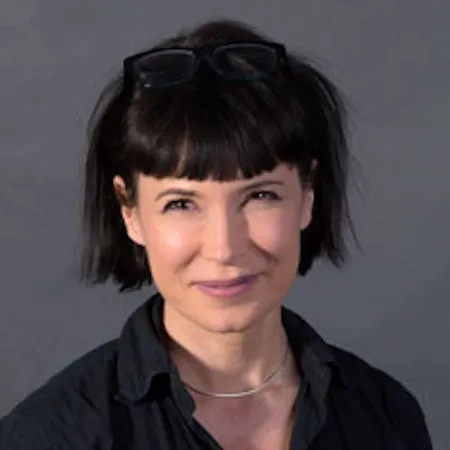In Sentences on Conceptual Art, Sol LeWitt states: “Rational judgments repeat rational judgments. Irrational judgments lead to new experience.” By asking irrational questions, artists can push scholarly enquiry in unanticipated directions. Visual artist Eliz Demaray programs listening stations for birds that play human music, cultures lichen on the sides of skyscrapers in New York City and builds floraborgs, which are machine learning systems that allow potted plants to roam freely in search of sunlight and water.
Demaray began working across academic disciplines in 1997, when, as a grad student at UC Berkeley, she created synthetic shelters for land hermit crabs for her Hand Up Project: Attempting to Meet the New Needs of Natural Life Forms. Due to a loss of seashells on global shorelines, this species, which adopts these structures to survive, faces a severe housing shortage. Utilizing an early form of adaptable 3D printing, Demaray redesigned a univalve shell to better fit the needs of this natural life form. Considered an early success in trans-species digital design, the project humorously solicited corporate sponsorship, offering to place a logo on each synthetic shelter in exchange for the funds needed to manufacture the dwellings.
In her presentation, Demaray will talk about several artworks she has authored in which science is an integral component. She will also lead a discussion on the ways that art and science collaboration can initiate innovation, raise awareness of ecological issues and highlight current scholarly research. Finally, she will address the challenges and rewards inherent in soliciting institutional support, dealing with the media and presenting work in this genre of applied practice.
Presenters

Elizabeth Demaray

Elizabeth Demaray
As a sculptor, Elizabeth's primary interest is the relationship of the built environment to the natural world. The artworks she makes are site-specific, materials-based, and community-supported. They often concern biotopes, which are small environments where multiple species overlap, and the concept of trans-species design, which is the idea that the commonalities between living organisms are such that we can give other life forms a “hand up.” In this vein, she cultures lichen on the sides of skyscrapers in New York City, programs listening stations that allow birds to make human-type music choices, and designs alternative forms of housing for hermit crabs from man-made materials.
A collaboration with a biologist, an engineer and a computer scientist, her current artwork, The IndaPlant Project: An Act of Trans-Species Giving, entails building light-sensing robotic supports for houseplants. These moving floraborgs use machine learning to roam freely in a domestic environment in search of sunlight and water. Video of the floraborgs can been seen here. She is the recipient of the National Studio Award at the New York Museum of Modern Art/P.S.1 Contemporary Art Center, the New York Foundation for the Arts Fellowship in Sculpture, and the Featured Artist Award at the Association of Environmental Science Studies 2014 symposium, Welcome to the Anthropocene. Currently an associate professor of fine arts at Rutgers University–Camden, she is a co-founder of the Art and Artificial Intelligence Laboratory in the Department of Computer Science at Rutgers–New Brunswick, which is a lab dedicated to supporting artistic practice in the fields of computer vision and machine learning.